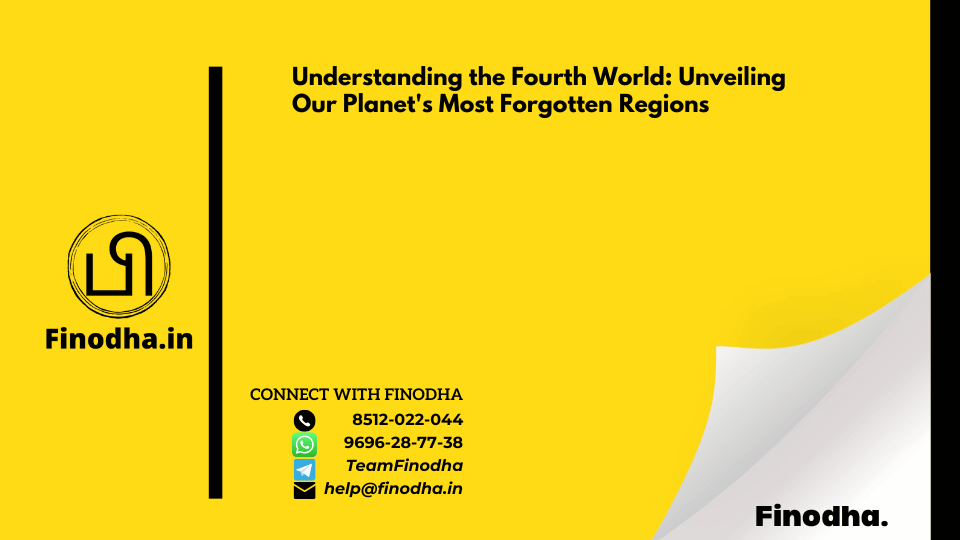Important Keyword: Fourth World, Indigenous Rights, Global Poverty, Cultural Preservation.
Table of Contents

Introduction to the Fourth World
The concept of the Fourth World encompasses regions of the world that are characterized by extreme poverty, political marginalization, and cultural disconnection. These areas, often inhabited by indigenous populations or communities with limited access to resources and opportunities, represent a significant portion of our planet that is frequently overlooked in global discussions. The term was first popularized by the Canadian sociologist George Manuel in the 1970s, highlighting the plight of indigenous peoples and their struggles against systemic oppression.
The Fourth World serves as a critical reminder of the disparities that exist between economically advanced nations and those areas where development has stagnated. Within the Fourth World, inhabitants typically maintain traditional lifestyles, relying on subsistence farming, artisanal crafts, or other forms of communal living that are often at odds with modern economic systems. This disconnection not only renders these communities vulnerable to the impacts of globalization but also erases valuable cultural practices that have been sustained over generations.
In geographical terms, the Fourth World can be found in various locations, including remote regions in Africa, Asia, the Americas, and Oceania. These locations often lack basic services such as clean water, healthcare, and education. As a result, the populations in these areas struggle to meet their fundamental needs, compounding their vulnerabilities. Furthermore, their limited political influence means they are often excluded from decision-making processes that directly affect their lives and environments.
Understanding the Fourth World is essential for fostering global awareness regarding social justice and inequality. As governments and organizations aim to address these challenges, it becomes crucial to acknowledge not only the existence of the Fourth World but also the rich histories, resilience, and contributions of the communities within it. Engaging in dialogue to uplift these often-forgotten regions is a vital step towards achieving a more equitable global society.
Historical Context: The Cold War and Categorization of Nations
The concept of the Fourth World emerged during the Cold War, a period marked by intense geopolitical tensions between the Western and Eastern blocs. In this era, nations were classified into three distinct categories: the First World, which encompassed the capitalist nations aligned with the United States; the Second World, which included the communist states under Soviet influence; and the Third World, a term used to describe developing countries that did not clearly belong to either camp. This classification system was primarily driven by global political dynamics, economic relationships, and the prevailing ideologies of the time.
As the Cold War progressed, it became apparent that certain nations and populations were overlooked within this dichotomous framework. These groups often faced systemic neglect due to their marginalization in the global economic system and their lack of significant political power. As a response to this oversight, sociologists and political theorists began to identify a Fourth World, representing indigenous peoples and marginalized nations who were not only economically disadvantaged but also vocally dispossessed of their rights and identities.
The categorizations of the First, Second, and Third Worlds served to simplify and structure the complexities of international relations during the Cold War. However, they failed to acknowledge the unique challenges faced by those outside this binary. The Fourth World thus represents a vital recognition of those populations that exist on the periphery of global development and economic systems, highlighting issues of poverty, social injustice, and the quest for self-determination. Understanding this historical context is crucial for comprehending the ongoing struggles these populations face today as they navigate the remnants of Cold War legacies and assert their place in a rapidly evolving world.
Defining Characteristics of Fourth World Nations
The term “Fourth World” refers to the nations that exist within the contrasts of modern global development, often characterized by extreme poverty and marginalization. These regions are typically home to indigenous populations striving for self-determination while facing systemic neglect. One of the defining traits of Fourth World nations is the persistent state of extreme poverty. According to global indices, these regions frequently showcase some of the lowest human development scores. Many inhabitants endure inadequate access to essential services such as education, healthcare, and clean water, fundamentally hindering their quality of life.
Moreover, a pivotal characteristic of Fourth World nations is the limited economic growth. Unlike their counterparts in developed regions, these nations lack the infrastructure and investment necessary to stimulate economic development. Often, they depend heavily on subsistence agriculture or informal economies, which can perpetuate cycles of poverty and hinder opportunities for advancement. Consequently, many Fourth World populations struggle to forge pathways toward economic self-sufficiency, largely due to the systemic inequities that have historically disadvantaged them.
In addition to economic challenges, Fourth World nations are distinguished by their unique cultural identities. Indigenous peoples residing in these regions maintain rich traditions, languages, and social structures that are often at risk of erosion from external forces. For instance, the Maori of New Zealand and the Navajo Nation in the United States epitomize the resilience of Fourth World cultures. By preserving their customs and advocating for their rights, these communities strive to maintain their identities, contributing to the rich tapestry of human diversity in often overlooked segments of the globe.
These defining characteristics underscore the complexities faced by Fourth World nations, highlighting the urgent need for targeted interventions that respect and support their unique circumstances and aspirations.
Socioeconomic Challenges Faced by Fourth World Regions
The Fourth World regions represent some of the most marginalized and underdeveloped areas on the planet, hosting populations that encounter significant socioeconomic challenges. One of the foremost issues is the profound lack of access to education. In many of these regions, educational facilities are either non-existent or of substandard quality. This educational deficit hampers individual potential, perpetuates poverty, and stifles overall community development, leading to a cycle that is difficult to break.
Healthcare is another critical concern. Fourth World populations often face barriers that prevent them from receiving adequate medical care. These barriers include insufficient healthcare infrastructure, a shortage of trained medical professionals, and economic constraints that render healthcare unaffordable. Consequently, individuals in these regions suffer from high rates of preventable diseases, malnutrition, and inadequate maternal and child health services. The lack of preventive care exacerbates health issues and diminishes life expectancy, further entrenching these communities in poverty.
Basic infrastructure, such as roads, clean water, and sanitation, is frequently lacking in Fourth World regions. The absence of reliable infrastructure not only impedes access to essential services but also restricts economic opportunities. Without proper transportation, residents struggle to engage in trade, seek employment, or access educational institutions and healthcare facilities. This detachment from the global economy limits potential revenue streams and reinforces the social and economic isolation of these populations.
Moreover, these socioeconomic challenges are compounded by geopolitical factors, including social conflict and political instability, which further alienate Fourth World regions from mainstream development efforts. The cumulative impact is a complex web of disadvantage that undermines the resilience and progression of communities, emphasizing the urgent need for targeted interventions to address these critical issues.
Removal from Mainstream Society: An Analysis of Isolation
The concept of the Fourth World encompasses regions and communities that exist on the peripheries of mainstream society, often characterized by profound isolation from global economic and cultural systems. This exclusion primarily affects indigenous tribes and remote populations, leading to distinctive lifestyles that are greatly different from the modern societal frameworks prevalent today. The underlying factors contributing to this isolation are multifaceted, encompassing historical, geographical, economic, and sociopolitical elements.
Historically, many of these communities have faced colonization, forced relocation, and cultural assimilation, which have severed their ties to broader societies. This historical context is crucial in understanding their current status; as these groups retreated from mainstream societal pressures, they cultivated self-sufficient lifestyles that prioritize traditional practices and values. This self-sufficiency, while a testament to their resilience, also results in economic disconnection. Incentives to engage in global trade or modernization often conflict with their cultural identity and practices, further entrenching their isolation.
Geographically, many Fourth World nations inhabit remote areas that are difficult to access. The inaccessibility limits outside influence and fosters an environment where traditional ways of life can persist. This natural barrier, while protective, can also exacerbate social and technological inequalities. As advances in communication and commerce transform the world, these isolated communities often remain untouched, placing them further at odds with the global economy. Importantly, their seclusion allows them to preserve cultural heritage, but it simultaneously restricts opportunities for development and integration, leading to persistent economic challenges.
In conclusion, the isolation of Fourth World communities from mainstream society is not merely a byproduct of geographic location but a complex interplay of historical, economic, and cultural factors. Understanding these dimensions is essential for any efforts aimed at fostering inclusivity and addressing the challenges faced by these marginalized groups.
Political Recognition and Status of Fourth World Populations
The Fourth World encompasses a unique geopolitical landscape marked by the absence of political sovereignty and formal recognition. Fourth World populations, often indigenous groups, experience challenges arising from artificially imposed political borders that do not align with their cultural or social realities. This discrepancy frequently leads to governance issues, as important decisions regarding land rights, resource management, and cultural preservation are influenced by external authorities disconnected from the communities themselves.
Take, for example, the First Nation groups in the Americas. These populations, such as the Navajo Nation, the Haudenosaunee Confederacy, and various others, possess rich cultural heritages and deep historical ties to their ancestral lands. Despite this, they often find themselves negotiating with state and federal governments that fail to fully recognize their political status. This lack of recognition inhibits their ability to self-govern and exercise autonomy over their territory and resources, ultimately undermining their rights as distinct peoples.
Political recognition is not merely a matter of semantics but plays a critical role in how these communities are able to sustain their traditions, manage their resources, and advocate for their rights. Consequently, advocacy efforts have emerged to emphasize the importance of treaties and agreements that respect the inherent rights of Fourth World populations. There is a growing understanding that external political frameworks need a reevaluation to more accurately reflect the self-identities and aspirations of these groups.
Furthermore, the United Nations Declaration on the Rights of Indigenous Peoples (UNDRIP) serves as a guiding instrument highlighting the importance of recognition and the protection of the rights of indigenous populations worldwide. Yet, implementation remains uneven and often lacks the necessary political will from various governments to ensure that Fourth World communities can flourish. Ultimately, the quest for political status and recognition continues to be a pivotal element in the struggle for justice and equality among Fourth World populations.
Global Impact: The Role of Fourth World in the Broader Context
The concept of the Fourth World encapsulates societies and regions that remain on the periphery of global discourse, often characterized by their marginalized status within the international community. While these nations may contribute minimally to global economic output, the implications of their existence are profound and multifaceted, influencing international politics, economic development, and cultural exchanges.
Firstly, in the arena of global politics, Fourth World nations often arise as unique focal points of discourse concerning human rights, environmental justice, and cultural preservation. They illuminate critical issues such as resource exploitation, sovereignty, and the adverse effects of globalization. As these regions voice their concerns on the global stage, they compel more economically powerful nations to reassess their policies and practices regarding indigenous rights and cultural heritage, thereby influencing international discussions and promoting more equitable policies.
Secondly, the economic ramifications of Fourth World nations extend beyond their borders. Their rich cultural heritage, including languages, traditions, and knowledge systems, offers diverse perspectives that contribute to global identity. While the direct economic output from these regions is often low, the potential for sustainable tourism, fair trade, and environmental stewardship can be leveraged to stimulate economic growth. As awareness of the importance of sustainable practices increases, Fourth World nations are positioned as crucial participants in the global economy, enriching it with their unique resources and perspectives.
Culturally, Fourth World nations serve as custodians of heritage that may otherwise be lost in a homogenizing world. The exchange of traditional knowledge and practices not only fosters cultural diversity but also enriches the global community, encouraging a broader understanding of humanity’s interconnectedness. The narratives and innovations emerging from these regions contribute to a richer, more inclusive global culture.
In conclusion, the existence of Fourth World nations plays a critical role in shaping global politics, economic systems, and cultural ecosystems. Acknowledging and valuing these regions not only empowers marginalized communities but also enhances the collective human experience across the globe.
Examples of Fourth World Nations: A Closer Look
In examining the concept of Fourth World nations, it is essential to highlight specific groups that embody the unique characteristics of these marginalized communities. One prominent example can be found among the indigenous tribes of South America, such as the Yanomami people. Residing primarily in the Amazon rainforest, these tribes face significant challenges as they navigate the preservation of their rich cultural heritage amid encroaching external influences. The Yanomami maintain a subsistence lifestyle, relying heavily on hunting, gathering, and fishing, which are increasingly threatened by deforestation and mining activities initiated by outsiders. This not only endangers their means of survival but also places their traditional knowledge and languages at risk of extinction.
Similarly, the Aboriginal peoples of Australia represent another vivid illustration of Fourth World nations. Historically subjected to colonization, these communities have experienced profound disruptions to their social structures, land access, and cultural practices. The Yolŋu people, who inhabit the northeastern regions of Arnhem Land, are actively engaged in a struggle to reclaim their rights to land and sovereignty. Their rich spiritual connection to the land is reflected in their artwork, music, and storytelling, ensuring their cultural identity endures despite the prolonged effects of marginalization.
Furthermore, the Sami people of Northern Europe also exemplify the conditions of Fourth World nations. Spread across Norway, Sweden, Finland, and Russia, the Sami have traditionally relied on reindeer herding and fishing for sustenance. As modernization progresses, the Sami face increasing pressures from industrial development and climate change, which threaten their livelihoods and cultural practices. Their struggle for recognition of land rights and cultural preservation embodies the broader challenges faced by Fourth World populations globally.
These examples spotlight the lived experiences of Fourth World nations, underscoring their resilience in the face of sustained adversity and their continuing efforts to preserve their identity, cultures, and ways of life.
Conclusion and Key Takeaways
In light of the discussions presented throughout this blog post, it is crucial to recognize the significance of the Fourth World, a term that encompasses regions and populations often overlooked in global narratives. These areas, characterized by a blend of impoverished communities, indigenous groups, and those facing systemic neglect, reveal the complexities associated with social and economic disparities. Understanding the Fourth World not only highlights the urgent need for advocacy and support but also influences broader conversations around human rights, environmental sustainability, and cultural preservation.
The key takeaways from this exploration underscore the resilience of Fourth World communities despite the challenges they face. Often, these populations possess a rich cultural heritage and a deep connection to their land, elements that can serve as powerful catalysts for their development and empowerment. By recognizing the unique perspectives and solutions offered by these communities, global stakeholders can engage in more meaningful dialogues that acknowledge their agency. This leads to more effective strategies that incorporate local knowledge and practices, ultimately fostering sustainable development efforts.
Furthermore, the implications of neglecting the Fourth World can reverberate beyond their immediate contexts, affecting global stability and cooperation. Addressing these complex issues requires a multifaceted approach that includes policy reform, greater awareness, and collaboration across various sectors. As we strive for a more equitable world, acknowledging the existence and rights of Fourth World populations is paramount. By doing so, we not only honor their history and struggles but also build a more inclusive future where all voices are heard and valued. In conclusion, let us move forward with a commitment to explore and understand the realities of the Fourth World, paving the way for collective growth and understanding.
Download Pdf: https://taxinformation.cbic.gov.in/





0 Comments